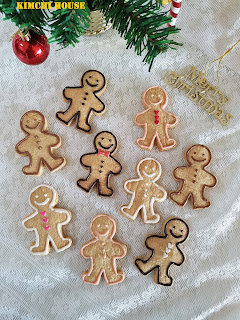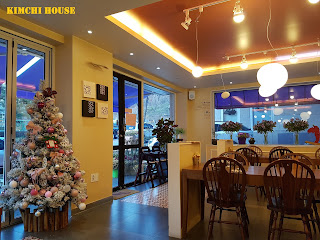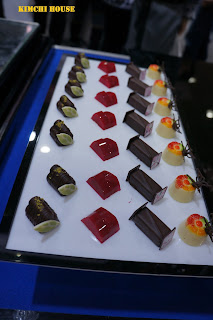Saturday, December 31, 2016
Saturday, December 24, 2016
Baked the Christmas cookies on Christmas Eve 2016
Friday, December 23, 2016
Merry Christmas / 圣诞快乐 / 메리 크리스마스 2016
Dear friends, may your heart and home be filled with all of the joys the season brings. Merry Christmas and a wonderful New Year ! Best wishes from Kimchi House~~
亲爱的朋友们,在圣诞和新年来临之际,祝福您平安、快乐、幸福!
즐거운 크리스마스 되시기 바랍니다 ! 메리 크리스마스 ~~
Tuesday, December 20, 2016
단팥죽 /(红豆羹/粥)/Red Bean Puree/ " Patjook"
단팥죽 /(红豆羹/粥)/Red Bean Puree " Patjook"
With my best wishes for "Happy Winter Solstice" to all of my friends ~~
恭祝大家 “冬至愉快” ~~
恭祝大家 “冬至愉快” ~~
Red Bean Puree with glutinous rice balls is served on the winter solstice, we call it "Patjook" in Korean.
今年的 12月21日是冬至(동지 ),韩国人也在这一天庆祝这节日。华族在这一天搓汤圆,韩国人则在这一天煮红豆羹/粥庆祝冬至。。。。
The Winter Solstice Festival or The Extreme of Winter (Chinese and Japanese: 冬至; Korean: 동지; Vietnamese:Đông chí) (Pinyin: Dōng zhì), (Rōmaji: Tōji), (Romaja:Dongji) is one of the most important festivals celebrated by the Chinese and other East Asians during the dongzhi solar term on or around December 22 when sunshine is weakest and daylight shortest; i.e., on the first day of the dongzhi solar term.
The origins of this festival can be traced back to the yin and yang philosophy of balance and harmony in the cosmos. After this celebration, there will be days with longer daylight hours and therefore an increase in positive energy flowing in. The philosophical significance of this is symbolized by the I Ching hexagram fù (復, "Returning").
Traditionally, the Dongzhi Festival is also a time for the family to get together. One activity that occurs during these get togethers (especially in the southern parts of China and in Chinese communities overseas) is the making and eating of Tangyuan (湯圓, as pronounced in Mandarin Pinyin: Tāng Yuán) or balls of glutinous rice, which symbolize reunion.
In Korea, similar balls of glutinous rice (Korean: 새알심) (English pronunciation:Saealsim), is prepared in a traditional porridge made with sweet red bean (Korean: 팥죽) (English pronunciation:Patjook). Patjook was believed to have a special power and sprayed around houses on winter solstice to repel sinister spirits. This practice was based on a traditional folk tale, in which the ghost of a man that used to hate patjook comes haunting innocent villagers on the winter solstice.
(source : Wikipedia )
Recipe is available at http://kkimchi88.blogspot.kr/…/red-bean-puree-patjook_8653.…
The origins of this festival can be traced back to the yin and yang philosophy of balance and harmony in the cosmos. After this celebration, there will be days with longer daylight hours and therefore an increase in positive energy flowing in. The philosophical significance of this is symbolized by the I Ching hexagram fù (復, "Returning").
Traditionally, the Dongzhi Festival is also a time for the family to get together. One activity that occurs during these get togethers (especially in the southern parts of China and in Chinese communities overseas) is the making and eating of Tangyuan (湯圓, as pronounced in Mandarin Pinyin: Tāng Yuán) or balls of glutinous rice, which symbolize reunion.
In Korea, similar balls of glutinous rice (Korean: 새알심) (English pronunciation:Saealsim), is prepared in a traditional porridge made with sweet red bean (Korean: 팥죽) (English pronunciation:Patjook). Patjook was believed to have a special power and sprayed around houses on winter solstice to repel sinister spirits. This practice was based on a traditional folk tale, in which the ghost of a man that used to hate patjook comes haunting innocent villagers on the winter solstice.
(source : Wikipedia )
Recipe is available at http://kkimchi88.blogspot.kr/…/red-bean-puree-patjook_8653.…
Monday, December 12, 2016
"Shiraegi"(Dried Radish Leaves)/ /萝卜叶乾/시래기
Dear friends, did you throw away the radish leaves after making the kimchi or whenever you buy the radish ?
"Shiraegi"/시래기 are the Dried Radish Leaves in Korean. This is also one of the main ingredients for me when I prepare the bibimbab.
Last Sunday, my youngest daughter recommended me to have " Shiraegi Jong Sik"/"Shiraegi Set Meal at a restaurant in Bundang,고에 꽃시래.
"Shiraegi rice"/萝卜叶乾饭~~
The"Shiraegi" of this restaurant are from Yanggu city, located in northern Gangwon province~~
这餐馆的萝卜叶乾是产自 江源道德杨口~~
"Godeungeo-jorim"/Braised mackerel together with the "shiraegi", the taste was good ~
"Godeungeo-jorim" 采用萝卜叶乾炖青花鱼, 味道很好~~
"Shiraegi" are the dried radish leaves in Korean. Normally, we dry them under the sun after blanching them in the hot water. Are low in calories, high in fiber, contain vitamin A,C,B1 and B2.
“Shiraegi",在韩文是指萝卜叶乾。 通常是将萝卜叶轻轻的在热水中汆一下, 然后在阳光下晒干它。 低卡路里,高纤维,含有丰富的维他命A,C,B1和B2。
Perilla seeds & shiraegi soup/苏子叶种子和萝卜叶乾汤~~
At the entrance of the restaurant~~
餐馆的外貌~~
”Jeyuj bokkeum"/stir fried pork~~
辣炒猪肉~~
"Dotorimuk"/acorn jelly; zucchini, carrot,"samchae"/allium hookeri~~
”Dotorimuk"橡子凉粉;节瓜。红萝卜,“samchae"凉拌宽叶韭根~~
"Japchae" /凉拌通心面~~
Fried pan cake/煎饼~~
"당근정과"/Sugarized carrot, this was the first time I tasted this dish, was very impressed~~
"당근정과"甜酿红萝卜,这是我第一次尝到这小菜,留下深刻的印象~~
"Omija tea"/五味子茶
Table setting/餐桌摆设~~
One of the corners of the restaurant/餐馆内的一角落~~
"Shiraegi" are the dried radish leaves in Korean. Normally, we dry them under the sun after blanching them in the hot water. Are low in calories, high in fiber, contain vitamin A,C,B1 and B2.
“Shiraegi",在韩文是指萝卜叶乾。 通常是将萝卜叶轻轻的在热水中汆一下, 然后在阳光下晒干它。 低卡路里,高纤维,含有丰富的维他命A,C,B1和B2。
One of the corners of the restaurant/餐馆内的一角落~~
One of the corners of the restaurant/餐馆内的一角落~~
One of the corners of the restaurant/餐馆内的一角落~~
One of the corners of the restaurant/餐馆内的一角落~~
"Shiraegi"/시래기 are the Dried Radish Leaves in Korean. This is also one of the main ingredients for me when I prepare the bibimbab.
Last Sunday, my youngest daughter recommended me to have " Shiraegi Jong Sik"/"Shiraegi Set Meal at a restaurant in Bundang,고에 꽃시래.
"Shiraegi rice"/萝卜叶乾饭~~
The"Shiraegi" of this restaurant are from Yanggu city, located in northern Gangwon province~~
这餐馆的萝卜叶乾是产自 江源道德杨口~~
"Godeungeo-jorim"/Braised mackerel together with the "shiraegi", the taste was good ~
"Godeungeo-jorim" 采用萝卜叶乾炖青花鱼, 味道很好~~
"Shiraegi" are the dried radish leaves in Korean. Normally, we dry them under the sun after blanching them in the hot water. Are low in calories, high in fiber, contain vitamin A,C,B1 and B2.
“Shiraegi",在韩文是指萝卜叶乾。 通常是将萝卜叶轻轻的在热水中汆一下, 然后在阳光下晒干它。 低卡路里,高纤维,含有丰富的维他命A,C,B1和B2。
Perilla seeds & shiraegi soup/苏子叶种子和萝卜叶乾汤~~
At the entrance of the restaurant~~
餐馆的外貌~~
”Jeyuj bokkeum"/stir fried pork~~
辣炒猪肉~~
"Dotorimuk"/acorn jelly; zucchini, carrot,"samchae"/allium hookeri~~
”Dotorimuk"橡子凉粉;节瓜。红萝卜,“samchae"凉拌宽叶韭根~~
"Japchae" /凉拌通心面~~
Fried pan cake/煎饼~~
"당근정과"/Sugarized carrot, this was the first time I tasted this dish, was very impressed~~
"당근정과"甜酿红萝卜,这是我第一次尝到这小菜,留下深刻的印象~~
"Omija tea"/五味子茶
Table setting/餐桌摆设~~
One of the corners of the restaurant/餐馆内的一角落~~
"Shiraegi" are the dried radish leaves in Korean. Normally, we dry them under the sun after blanching them in the hot water. Are low in calories, high in fiber, contain vitamin A,C,B1 and B2.
“Shiraegi",在韩文是指萝卜叶乾。 通常是将萝卜叶轻轻的在热水中汆一下, 然后在阳光下晒干它。 低卡路里,高纤维,含有丰富的维他命A,C,B1和B2。
One of the corners of the restaurant/餐馆内的一角落~~
One of the corners of the restaurant/餐馆内的一角落~~
One of the corners of the restaurant/餐馆内的一角落~~
Tuesday, December 6, 2016
Tangerines Chips/蜜柑片/감귤칩
Dear friends, tangerines are most commonly peeled and eaten out of hand. The fresh fruit is also used in salads, desserts and main dishes. Instead of this, have you ever tried to eat the tangerines chips ?
This year, I do received a box of organic tangerines from Jeju Island, as a gift from a friend. Made the tangerines chips. The taste is good and crispy~~
If you are interested to know the process, please refer to my last post as in http://kkimchi88.blogspot.kr/2014/12/tangerines-chips.html
朋友们,一般上, 我们都会剥了柑皮, 吃其果肉;我们也用它来做沙拉,甜品等。除此之外, 您可曾尝过蜜柑片 ?
今年,又收到朋友送来的一箱济州岛有机蜜柑,做了蜜柑片。 味道很好,而且很脆~~
Friday, December 2, 2016
Chocolates/巧克力/초콜릿
Dear friends, do you like chocolates ? Share with you the chocolates that I took at the food fair in COEX recently ~~
亲爱的朋友们, 您可喜欢巧克力? 与您分享最近在 COEX 食品展会上所展出的巧克力 ~~
亲爱的朋友们, 您可喜欢巧克力? 与您分享最近在 COEX 食品展会上所展出的巧克力 ~~
Subscribe to:
Comments (Atom)
























































